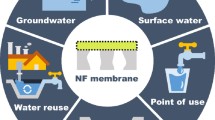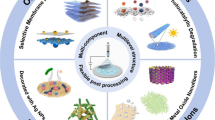Abstract
In this study, two composite nanofibrous membranes of Polyvinylidenefluoride (PVDF) and [poly(vinylidenefluorideco-hexafluoropropylene)] (PVDF-co-HFP) prepared by the electrospinning process were employed in a direct contact membrane distillation (DCMD) system. We changed the pump flow rate and temperature difference to examine their effects on permeate flux and salt rejection. The SEM observations, porosity analyzer technique, and contact angle measurement indicated the nanobrous membrane with an average fiber diameter of 170 nm and maximum pore diameter distribution of 0.3 µm is the best membrane for the DCMD system. However, the ability of the hydrophobic membrane affects the filtration efficiency of the DCMD system. The contact angle of the PVDF-HFP electrospun membrane (128°) shows better hydrophobic than the PVDF electrospun membrane (125 °). From the experiment of 12 hours, the salt rejection of PVDFHFP (99.9901 %) was better than that of PVDF composite membrane (99.9888 %) and was almost the same as that of the PTFE commercial membrane (99.9951 %). In addition, the permeate flux of the PVDF-HFP composite membrane is 4.28 kg/ m2hr higher than the PTFE commercial membrane.
Similar content being viewed by others
References
A. D. Khawaji, I. K. Kutubkhanah, and J. M. Wie, Desalination, 221, 27 (2008).
C. Charcosset, Desalination 245, 214 (2009).
G. Micale, A. Cipollina, and L. Rizzuti, “Seawater Desalination for Freshwater Production Seawater Desalination”, pp.1–15, Springer Berlin Heidelberg, Germany, 2009.
N. Dow, J. Zhang, M. Duke, J. Li, S. R. Gray, and E. Ostarcevic, “Membrane Distillation of Brine Wastes Research Report 63”, Water Quality Research Australia, Adelaide, 2008.
A. Kullab and A. Martin, Separation and Purication Technology, 76, 231 (2011).
M. S. El-Bourawi, Z. Ding, R. Ma, and M. Khayet, J. Membrane Sci., 285, 4 (2006).
K. W. Lawson and D. R. Lloyd, J. Membrane Sci., 124, 1 (1997).
M. Qtaishat, D. Rana, M. Khayet, and T. Matsuura, J. Membrane Sci., 327, 264 (2009).
R. Lydon, E. Mayer, and G. R. Rideal, “Comparative Methods for the Pore Size Distribution of Woven and Metal Filter Media”, 9th World Filtration Congress, 2004.
Author information
Authors and Affiliations
Corresponding author
Rights and permissions
About this article
Cite this article
Su, CI., Shih, JH., Huang, MS. et al. A study of hydrophobic electrospun membrane applied in seawater desalination by membrane distillation. Fibers Polym 13, 698–702 (2012). https://doi.org/10.1007/s12221-012-0698-3
Received:
Revised:
Accepted:
Published:
Issue Date:
DOI: https://doi.org/10.1007/s12221-012-0698-3




